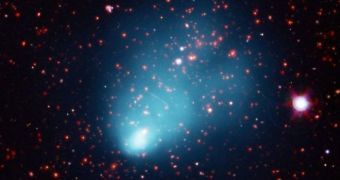El Gordo, meaning the fat one, is the oldest, most distant and most exceptional galaxy cluster discovered to date, say investigators behind a new study. The team discovered this structure at a distance of about 7 billion light-years from Earth.
The cluster is being observed at an age when it was still in its infancy. In all likelihood, it has since grown to tremendous size, and is exerting a controlling influence on its surroundings. Its official name is ACT-CL J0102-4915.
It was discovered by a collaboration of experts using the Chandra X-ray Observatory, one of the four Great Observatories developed by NASA, and the Chile-based Atacama Cosmology Telescope (ACT), which is sponsored by the US National Science Foundation (NSF).
Study leader Felipe Menanteau, who is based at the Rutgers University in New Brunswick, New Jersey, says that El Gordo is so remarkable because it is the hottest and largest galaxy cluster known to exist so far away from Earth. In addition, it gives off the highest amount of X-rays of any known cluster.
Such large-scale cosmic formations are made up of galaxies that come together in smaller groups called sub-clusters. Eventually, the latter merge to form the largest, gravity-bound structures in the Universe. Several clusters can then come together to form a galactic wall.
Dark matter and dark energy play a critical, yet little-understood role in the formation of galaxy clusters. This is why scientists are hoping that studying the latter will give them additional insights into the role the former two play in determining the ultimate fate of the Cosmos.
“Gigantic galaxy clusters like this are just what we were aiming to find. We want to see if we can understand how these extreme objects form using the best models of cosmology that are currently available,” adds Rutgers investigator Jack Hughes.
Astronomers know that dark matter cannot be observed directly at this point. Even though numerous types of detectors have been built, they have yet to identify any particle that could potentially make up dark matter. Yet, scientists know that the stuff exists because it interacts gravitationally with baryonic matter.
Details of the discovery will be announced in an upcoming presentation, to be held at the 219th meeting of the American Astronomical Society (AAS2012), in Austin, Texas. The work was also accepted for publication in a forthcoming issue of the esteemed Astrophysical Journal.

 14 DAY TRIAL //
14 DAY TRIAL //